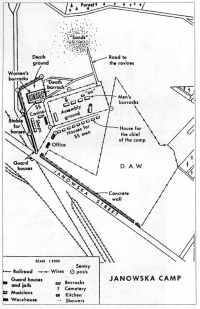 |
| Camp Map |
In
September 1941, the Germans set up a factory at 134 Janowska Street in the suburbs of
Lviv (Lwow / Lemberg) to service the needs of the German Army. Soon after,
they expanded it into a network of factories as part of the
Deutsche Ausrüstungwerke (
DAW –
German Armament Works), a division of the SS. From inception, Jews from
Lwow
were utilised as forced labour in these factories; by the
end of October, 600 Jews
were working there. At that point, the character of the factories changed.
A forced labour camp (
Juden-Zwangsarbeitslager) was established. The area became a restricted
camp, enclosed by barbed wire, which the Jews were not permitted to leave.
The Janowska complex consisted of three sections. The first comprised the garages, workshops and offices,
with a separate villa for the camp staff, SS, SD, and the Ukrainian guards. At the centre of this
section stood the villa of the camp commandant. The second section was the camp proper. Here barracks,
each housing 2,000 inmates, were erected for the Jewish labourers. The conditions in the barracks were
appalling. Prisoners slept on the ground or on planks. Sanitation was primitive, resulting in permanent
conditions of disease and sporadic outbreaks of epidemics. Many prisoners died of starvation; rations
consisted of black
Ersatzkaffee (coffee substitute) in the morning, a midday meal of watery soup
containing unpeeled potatoes, and 200 grams of bread in the evening. The third section of the camp
consisted of the
DAW factories. A barbed wire fence separated the three camp sections from each other,
and the entire camp was surrounded with a double barbed-wire fence illuminated with searchlights.
Watchtowers were placed all around the camp at 50 metre intervals, with armed Ukrainians and SS men
patrolling the perimeter.
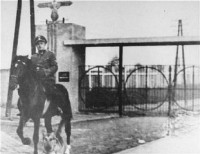 |
| Wilhaus at the Camp Gate * |
The first commander of the camp was
Fritz Gebauer. His deputies were
Gustav Wilhaus and
Wilhelm Rokita.
In
May 1942,
Gebauer took over the
command of the
DAW camp, and
Wilhaus was appointed commander of Janowska.
A staff of 12-15 SS officers, who were replaced from time to time, administered the camp. The guards at the
camp were Russian POWs who had volunteered for service with the SS.
The camp had originally been planned exclusively for Jews, but after several months a special section was set
up for Poles. They were separated from the Jews, received better treatment and were generally released from
the camp after a period of detention. In the first months, only Jews from Lwow were brought to the camp, but
later on Jews were sent to the camp from other districts including
Krakow.
Most of the Jews in the camp came from the East Galician District, and the sub-districts of
Rawa-Ruska, Kamionka Strumilowa, Sambor, Brzezany, and
Kaluz. The SS from the camp visited these districts from time to time for
extermination actions. Sub-branches of the Janowska camp were also established in
Laski Kurowice, Jaktarowe and other places to which the Jewish labourers of
the Janowska camp were transferred.
The Jews who were brought to the camp had to surrender all valuables on arrival. The Jewish prisoners were divided
into labour brigades (
Sonderkommandos) of 20-30 persons. They worked a 12-hour day, both in the camp
and in
Lviv, where they broke up tombstones in the Jewish graveyards.
The SS and Ukrainian Militia constantly supervised them. The prisoners also worked on various projects organised
by the SS. There was a special Jewish
Kommando engaged in the burying of the Jewish dead in the camp,
particularly those Jews executed on the sand-hills behind the camp. This
Kommando were also used to sort
the clothing and property of the dead.
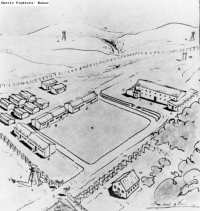 |
| Camp Sketch * |
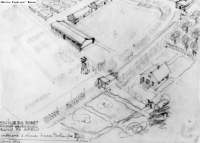 |
| "Out for Work" * |
The living conditions in the camp were exceptionally barbaric. Many prisoners committed suicide by hanging themselves
in the barracks, rather than face another day of cruelty. When they returned from work, the prisoners were made to run
into the camp.
Wilhaus and his assistant singled out those Jews who showed signs
of fatigue. These Jews were placed between the wire rows and left there to die. Each morning there was a roll call
for all prisoners, who were personally inspected by an SS officer. Any prisoner failing the inspection was
immediately shot.
Rokita had a special practice when passing through the rows
of prisoners on the parade ground. If he did not like a prisoner he would shoot him in the back of the neck.
Every SS man had his favourite or special way of killing. Jews in the camp were murdered for the slightest
misdemeanour; for working slowly, for not paying attention, some for no reason at all. The manner in which a Jew was
killed varied, depending on the executioner; shooting, flogging, choking, hanging, fixing to crosses with the head
down, cutting to pieces with knives or axes. Distinctive procedures were adopted when killing women. They were mostly
flogged to death or killed by stabbing. The Nazis conducted their tortures, beatings and shootings to the
accompaniment of music. For this purpose they organised a prisoners orchestra, led by Professor
Stricts and the well-known conductor
Mund. Composers were ordered to write a special tune, which was
called "The Death Tango". Shortly before the camp was liquidated the Nazis shot all members of the orchestra.
Barrack No.5, which was occupied by the
Ostbahn-Brigade, who were Jews working at the railway station,
scrubbing and cleaning locomotives, was the subject of intense SS brutality. This brigade also supplied the largest
quotas for executions. On
16 March 1943, following the killing of an SS man by the Jew
Kotnowski, 30 members of the brigade were summarily shot as
a reprisal. A further 11 Jewish policemen were hanged from balconies in the main street of the
Lviv Ghetto. Nearly 1,000 Jews were taken out of other working groups outside the
camp and shot. A further 200 Jews in Janowska itself were also shot.
When the mass deportation of Jews from Eastern Galicia to
Belzec began in
March 1942, the status of the camp had changed yet again. It became a transit camp
for Jews from towns and villages in the area. Inside the camp, selections of those considered fit for labour took
place; those not selected were transported to
Belzec.
Later in the spring of that year, Janowska was enlarged and took on the character of a concentration camp.
Following "actions" in
Lviv in the
summer of 1942,
thousands more Jews were sent to the camp. By
mid-1943, whilst still functioning as
a labour camp, Janowska was now being turned into an extermination camp. Fewer prisoners were employed in the
factories inside the camp and in
Lviv, and the length of stay of newcomers
was shortened.
The executions took place in the
Piaski sand-hills behind the camp. There were
two slopes on which Jews were shot and then buried in pits. In
mid-May 1943 alone, over
6,000 Jews were murdered there.
Under
Gebauer, a savage system of extermination was instituted
at the Janowska Camp. After his appointment to another post this system was "perfected" by camp commandant
Wilhaus and his assistant
Franz Warzok.
From the testimony of many Soviet POWs as well as French subjects held in German camps, it was ascertained that
the Nazis "invented" most refined methods for the extermination of human beings. This initiative was regarded as
a matter of special merit at Janowska.
Horrific atrocities were an everyday occurrence. One unnamed witness told the Soviet Special Commission of Enquiry:
"
I saw Gebauer strangle women and children with my own eyes.
I saw them place men in barrels of water to freeze in the depth of winter. The barrels were filled with water and then
the victims were tied hand and foot and put into the water. The doomed people remained in the barrels until they froze
to death."
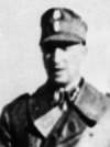 |
| Wilhaus * |
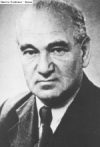 |
| Rokita * |
Wilhaus, partly for sport, and partly to amuse his wife and daughter,
used regularly to fire a machine-gun from the balcony of the camp office at prisoners occupied in the workshops.
Then he would pass the machine-gun to his wife, who also shot at them. On one occasion, to please his nine-year-old
daughter,
Wilhaus made someone toss two four-year-old children into the air,
while he fired at them. His daughter applauded and cried, "
Papa, do it again, papa, do it again!" He did so.
Warzok liked to hang prisoners on poles by their feet, and leave them
in this position until they died.
Rokita personally ripped open prisoners’
stomachs. The Chief of the Investigation Department of the Janowska Camp,
Heine, used to perforate the bodies of prisoners with a spike or iron rod;
he would to pull out the finger-nails of women prisoners with pliers, then undress his victims, hang them by the
hair and set them swinging, before shooting at the "moving target". In Janowska, prisoners were murdered on any
pretext, often for a bet.
The victims were not always Jewish. The witness
Kirschner
informed the Soviet Special Commission after the war that
Wepke, a
Gestapo
Kommissar, boasted to other camp executioners that he could cut a boy in two parts with one blow of a hatchet.
His colleagues did not believe him, so he caught a ten-year-old boy in the street, forced him to his knees, then
made the boy put his palms together to hide his face.
Wepke made a trial stroke,
adjusted the boy’s head, and with a single blow of the hatchet slashed him in two. The Nazis congratulated
Wepke warmly, and shook him by the hand.
On
2 March 1942, the first day of Purim, six Jews were forced to spend the
night outside the barracks, on the grounds that they "looked sick" and should not infect others. The temperature
was below freezing point. "
In the morning",
Leon Wells (Wieliczker) recalled:
"
all six people were frozen lying down where they were put out the night before; completely
white like long balls of snow." On
4 March 1942,
Gebauer ordered a barrel of water to be brought and picked out
eight more labourers from Janowska. The eight Jews were forced to undress and were then place in the barrel.
They remained in the barrel all night. In the morning
Wieliczker recalled,
"
we had to cut the ice away. The men were frozen to death."
A week later,
Gebauer and
Wilhaus
began a game whereby they used the Jewish labourers, who were walking in the camp, as target practice. In the
evening, the same officers selected sick Jews and shot them.
Gebauer
was known for his sadistic strangling abilities. He would select a Jew and strangle him with his bare hands.
On
20 April 1943,
Hitler's fifty-fourth birthday,
Wilhaus picked out 54 prisoners and personally shot them. In the camp there
was a so-called hospital for prisoners. The Nazi executioners
Brambauer and
Birmann examined the patients on the 1st and 15th of every month.
If they found any patients who had been in hospital over a fortnight, they shot them on the spot. Six or seven people
were murdered during each such examination.
Miraculously,
Leon Wells (Wieliczker) survived internment in Janowska
twice, once as a prisoner condemned to death and then as a member of the
"
Sonderkommando 1005", forced to exhume and cremate the corpses of the murdered.
In his testimony at the trial of
Adolf Eichmann in
Jerusalem in
1961,
Wieliczker graphically described how, having first dug his own grave in the
sand hills of Piaski, he was ordered to fetch the body of a prisoner who had
been shot in the camp. Despite a raging fever, which caused him to lag behind his guard, he dragged the body of
the dead man towards the execution site. There was a moment when the guard’s back was turned.
Wieliczker seized the opportunity to drop the body and disappear into the camp.
The guard knew that he had lost
Wieliczker, and was afraid of the reactions
of his superiors. Anyone taken to Piaski could never return to the camp. And so the dead man was buried as if he were
Wieliczker. The numbers tallied and
Wieliczker
was officially dead. This was of vital importance. At that time, escaping from the camp was easy. The problem was
that if one prisoner escaped, the SS shot ten people from that person’s brigade and the family and relatives of
the escapee were hanged. Now that he knew that he was officially dead,
Wieliczker
understood that he could escape without endangering any of his fellow prisoners or his family. And escape he did,
only to be subsequently recaptured and returned to Janowska.
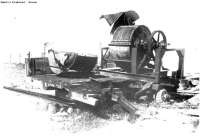 |
| The Bone-Crushing Machine * |
In
June 1943, the 126 man Jewish brigade of
Sonderkommando 1005 began the
exhumation and cremation of all those who had been murdered and buried in the
Lviv
District. The German officers in charge of and supervising this
Kommando were Sipo-SD
Scharführer Rauch and
Sipo-SD
Oberwachtmeister Kepick. The bodies recovered from the
pits were laid on special platforms in stacks, each containing 1,200-1,600 corpses. Tar and petrol were poured
over the bodies which were then burned. The ashes and bones were sifted in order to collect articles of value - gold
fillings, teeth, rings, watches etc. Eyewitness accounts testify that during the five months’ activity of this
"Death Kommando" 110 kilogrammes of gold were sifted out of the ashes and dispatched to Germany. The ashes were
scattered on the fields or buried; large bones were collected separately and crushed in a bone-crusher, which was
specially designed to speed up the "work". The bone-crusher supervisor was Sipo-SD
Scharführer Elitko. The Germans failed to destroy this bone-crusher,
which was later recovered by the Soviets and used as material evidence in war crimes trials in the Soviet Union.
Wieliczker was a member of the
Kommando, and described the procedure in his
evidence at
Eichmann’s trial:
"
We used to uncover all the graves where there were people who had been killed during the
past three years, take
out the bodies, pile them up in tiers and burn these bodies; grind the bones, take out all the valuables in the ashes
such as gold teeth, rings and so on - separate them. After grinding the bones we used to throw the ashes up in the
air so that they would disappear, replace the earth on the graves and plant seeds, so that nobody could recognize
that there was ever a grave there.
In addition to this they used to bring new people - new victims; they were shot there - undressed beforehand -
we had to burn these new bodies too. When on Tuesday, 29 June 1943, 275 people
arrived, they were shot with
a machine gun in groups of 25. After the first 25 stepped into the pit and were shot, the next 25 followed. The 275
that were shot that day explained something that we had found before. There were some graves where it didn't
seem to us that the people had been shot... Their mouths were open with their tongues protruding. They were more like
people who had suffocated. This told us that these people were buried alive, because when we came to burn the
bodies we found that some of them were only slightly injured due to the machine gun shooting 25 people in one burst...
So some of them were only slightly injured in the arm and they fell down and were buried beneath the bodies
above them. So it happened that this night when we picked up a body and put it in the fire, at the last moment
the person started to scream - yell aloud because they were still alive ...
The Brigade was divided into different corps. There were, in the beginning one, afterwards two Brandmeister
(Burn Masters), two Zähler (Counters), an "ash commander", carriers, pullers and also cleaners. The
Brandmeisters were in charge of the fire. When they put up a heap like a
pyramid, sometimes up to 2,000 bodies - one had to watch out so that the fire didn't go out. they were in charge
of the fire, while the Zähler was keeping a count of how many bodies were burnt to check out with the
original list - how many were killed, because if we uncovered a grave we were sometimes looking for hours for
one body or more if it was buried on the side; there was an exact list of how many people were killed. So the
Zähler kept the number of bodies burned and taken out of each grave. The report was made with pencil
and paper - it was forbidden for anybody to mention the number, and the Zähler himself had to forget.
So that if the Hauptscharführer or Untersturmführer next morning asked: "How many were burned
yesterday?" the Zähler couldn't say. He had to reply: "I forgot".
We had to make up songs and sing while we were going to work, and also the Brandmeister would march in
front, he was clothed like a devil; he had a special uniform with a hook in his hand and we had to march after
him and sing. Afterwards we were also joined by an orchestra which would play as we sang and accompany us
on our march to work.
We were told that after eight to ten days we had to be exchanged - we would be shot and another group
would come; so when visiting SD men came over to the Death Brigade and asked us how long we had been
there it was forbidden for us to say that we had been longer than six, eight, up to eight or ten days -
no longer..."
The Soviet Special Commission which investigated Nazi crimes after the war, found a number of pits full
of the bodies of prisoners shot during the second half of
July 1944. According to
the testimony of witnesses
and relatives of the murdered people, the Nazis used this place as an execution site for people brought
from various
Gestapo prisons. Contrary to their usual practise, the Nazis did not search the clothes of the
murdered people. The Commission found identification papers in the pockets of the clothes of those shot.
From these papers the identity of many of the victims was established. The Soviet Special Commission
also determined the following:
1. Mass murders of civilians were carried out in the Janowska Camp.
2. The murders were effected mainly by the standard German technique - shooting through the back of the head.
Some were murdered by a shot through the roof of the skull.
3. On the territory adjoining Janowska Camp the Germans carried out the mass burying and subsequent burning of
bodies. The burnings were spread over a period, and the sites were scattered over the territory of the camp,
but mostly they took place at
Piaski.
4. The earth at
Piaski proved to be saturated to a considerable depth with
corpse fluid and fats, together with the smell of decay and burning.
5. The nature of the ashes discovered, consisting of small pieces of bone, and the brittleness of the larger
bone fragments, testify that the burning of the bodies was carried out at a high temperature. The ashes
remaining after the bodies were burnt were buried in various places on the territory of the camp at a depth
of three to six feet; in all, 59 such sites were discovered. Moreover, ashes and bones were found on the
surface of the soil over nearly all of the camp territory examined by the Commission. Considering that the
total area of burials and scattering of ashes and bones occupied nearly two square kilometres, the commission
of experts considered that over 200,000 people were exterminated in Janowska.
In common with all of the Nazi killing sites, it is impossible to arrive at a precise total for the victims
of Janowska. Commissions investigating these sites immediately after WW2 generally tended towards
over-estimating the numbers murdered.
Wieliczker,
testified to the Soviet Special Commission:
"
I was a former inmate of the Janowska Camp who was ordered to work in the
Blobel Kommando 1005, compelled to work in this team engaged in exhuming
and burning bodies. I worked from 6 June 1943, to
20 November 1943. During this time the team burned more than 310,000 bodies,
including about 170,000 on the sand-stone of the Janowska Camp, and over 140,000 in the Lisincki
Forest. This number includes bodies which were exhumed by the Kommando, as well as those
which were not buried, and burned directly after shooting.
On 20 November 1943, our whole team escaped. Only a few remained alive - most
were killed while trying to escape. The Germans formed another team of prisoners, who continued with the work
of burning bodies. I do not know how many bodies were burned after my escape, but I know that burning of bodies
continued in the Lisincki Forest until January 1944."
Another witness,
Manussevich:
"
After burning the bodies in the gully, near the Janowska Camp, we were taken at night
on trucks to the Lisincki Forest, where we opened 45 pits full of bodies
of people who had been shot. From the uniforms, marks of distinction, buttons, medals and orders we identified
among the bodies Red Army men, French, Belgian and Italian war prisoners. There were also bodies of civilians
among them."
Current estimates of the total murdered of Janowska number between 100,000-200,000. Liquidation of
the corpse-burning squad began on
25 October 1943. When the final thirty or so Jews
of the
Sonderkommando left in Janowska realised their intended fate, they planned an escape.
Some Germans were killed during the course of the attempted breakout; their number, and that
of the Jews who succeeded in fleeing, is not known.
The Red Army liberated Lwow on
26 July 1944.
Gebauer
was tried by a West German court and sentenced to life imprisonment. In the post-war years,
Janowska remained a prison – Soviet Camp No.30. It still serves the same function in the Ukraine today.
Photos:
GFH
*
USHMM
*
Sources:
Unpublished Manuscript – Robin O’Neil
The Holocaust – Martin Gilbert – London, 1986
Lvov Ghetto Diary – David Kahane - Univ. of Massachusetts Press, 1991
Soviet Government Statements on Nazi Atrocities – London, 1946
The Trial of Adolf Eichmann – Transcripts -
www.nizkor.org/hweb/people/e/eichmann-adolf/transcripts/
Justiz und NS-Verbrechen -
www1.jur.uva.nl/junsv/index.htm
Encyclopedia of the Holocaust - Israel Gutman (Ed) - New York 1990.
© ARC 2005














